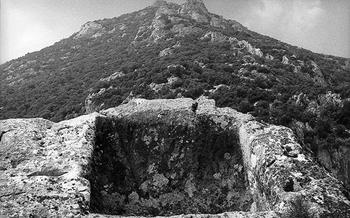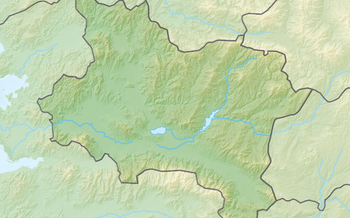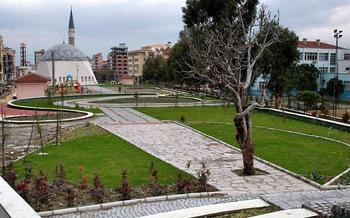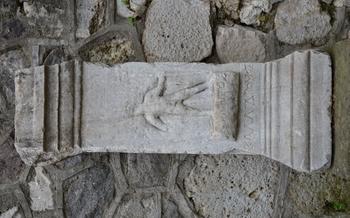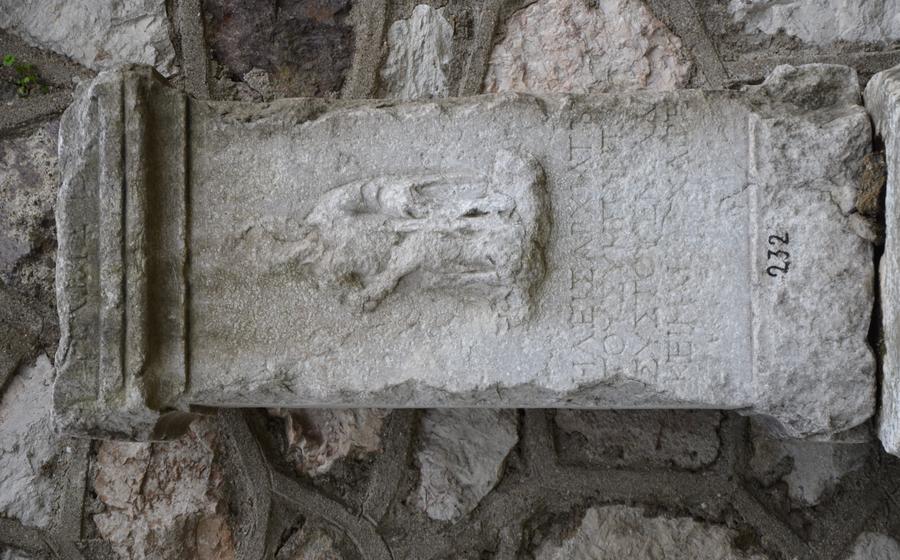
Crying Rock (Aglayan Kaya)
- The Crying Rock: An Overview
- Visiting the Crying Rock
- Exploring the Surrounding Area
- Things to See and Do at the Crying Rock
- Unique Features of the Crying Rock
- Scientific Explanations for the Tears
- Cultural Significance of the Crying Rock
- The Crying Rock in Literature and Art
- Conservation Efforts
- Impact of Tourism
The Crying Rock: An Overview
The Crying Rock, also known as Aglayan Kaya, is a remarkable natural wonder located in the mesmerizing province of Manisa, Turkey. Steeped in history and geological significance, this intriguing rock formation has captured the imagination of travelers and locals alike, captivating them with its unique features.
Nestled amidst the picturesque landscape of Manisa, the Crying Rock stands as a testament to the forces that have shaped our planet over millennia. Its intriguing geological composition, believed to have originated from volcanic activity millions of years ago, adds to its allure. With its strategic location close to the city center, the Crying Rock is easily accessible, making it a popular destination for visitors seeking a glimpse of this natural masterpiece.
Visiting the Crying Rock
The best time to visit the Crying Rock is during the spring or fall when the weather is pleasant and the surrounding landscapes are vibrant. The rock is accessible by car, and there is ample parking space available nearby. Visitors can explore the area on foot, admiring the rock formations and enjoying the natural scenery.
Entrance to the Crying Rock is free of charge, and it is open to the public throughout the year. Visitors can wander around the site at their leisure, taking photos and videos to capture the unique beauty of the rock. Guided tours are not available, but visitors can learn about the legend and history of the Crying Rock by reading the information boards displayed on-site.
Exploring the Surrounding Area
Nearby Attractions In addition to the Crying Rock, there are several other attractions in the surrounding area that are worth exploring. Nature lovers can take a hike in the nearby Spil Mountain National Park, which offers stunning views of the region. History buffs can visit the ancient city of Sardis, located just a short drive away, where they can explore the ruins of a once-thriving metropolis. For a unique cultural experience, visitors can head to the nearby village of Salihli, known for its traditional Turkish handicrafts and vibrant local markets.
Accommodation and Dining Options Manisa offers a range of accommodation options to suit every budget and preference. From cozy guesthouses and boutique hotels to modern resorts, there is something for everyone. Visitors can also indulge in the local cuisine at the many restaurants and cafes in the area. From traditional Turkish dishes to international fare, there are plenty of options to satisfy every palate.
Things to See and Do at the Crying Rock
The main attraction of the Crying Rock is simply admiring its unique rock formations and the tears that seem to flow down its surface. Visitors can spend hours marveling at the intricate patterns and textures of the rock, and watching the water droplets slowly drip down.
Photographers and videographers will find the Crying Rock to be a particularly rewarding subject. The constantly changing light and shadows create a variety of different moods and atmospheres, and the tears add a unique element of interest.
In addition to admiring the rock itself, visitors can also enjoy the natural scenery of the surrounding area. The Crying Rock is located in a beautiful valley, with lush vegetation and stunning views of the surrounding mountains. Visitors can take a leisurely walk along the nearby trails, or simply relax and enjoy the peace and tranquility of the natural surroundings.
Unique Features of the Crying Rock
The Crying Rock is a remarkable geological formation characterized by its distinct features. Its composition is primarily limestone, a sedimentary rock formed from the accumulation and compaction of calcium carbonate over millions of years. The constant flow of water has eroded the rock, creating intricate patterns and crevices that contribute to its distinctive appearance.
The formation process of the Crying Rock is a result of the natural processes of weathering and erosion. Over time, rainwater and other elements have seeped into the rock, causing it to dissolve and form small cavities. These cavities gradually expand, resulting in the formation of the characteristic tears that flow down the rock's surface.
One of the most distinctive features of the Crying Rock is its ability to "cry" during certain times of the year. This phenomenon occurs when water seeps through the cracks and crevices in the rock, creating a continuous flow of tears that cascade down its surface. The tears are most prominent during the spring and winter months when rainfall is abundant.
Scientific Explanations for the Tears
The tears of the Crying Rock are not merely a product of legend and folklore but have a scientific basis rooted in geological processes and environmental factors. Over time, the rock has been subjected to various geological forces and natural phenomena that have shaped its distinctive features, including the formation of tears.
Geological Processes:
The Crying Rock is composed of sedimentary rocks, primarily limestone and marl, which are susceptible to weathering and erosion. These rocks are prone to fracturing and creating cavities due to pressure changes, tectonic movements, and water infiltration. As water seeps into these cracks and cavities, it gradually dissolves the soluble minerals, leading to the formation of channels and pores within the rock.
Weathering and Erosion:
Weathering processes, such as wind, rain, and temperature fluctuations, contribute to the erosion of the rock's surface. Over time, these processes create small channels and grooves, which allow water to accumulate and seep through the rock's pores. The continuous flow of water through these channels leads to the gradual widening and deepening of the grooves, eventually forming the visible tears.
Hydrological Factors:
The Crying Rock is located near a natural spring, which contributes to the constant flow of water through the rock's pores. The spring water is rich in minerals, including calcium carbonate, which is deposited on the rock's surface as it evaporates. This mineral deposition forms stalactites and stalagmites, which further enhance the appearance of the weeping tears.
The combination of these geological processes and environmental factors has resulted in the formation of the Crying Rock's unique features, including the distinctive tears that have captivated visitors and fueled legends and myths for centuries. Understanding the scientific explanations behind the tears adds a layer of fascination to this natural wonder, highlighting the intricate interplay between geology and folklore.
Cultural Significance of the Crying Rock
The Crying Rock holds a profound cultural significance in the region, embodying a rich tapestry of emotions, beliefs, and traditions. It serves as a potent symbol of love and loss, inspiring a deep connection with the human experience. The rock has become a source of solace and reflection for those who have experienced the pain of heartbreak or loss, offering a sense of shared grief and understanding.
Over time, the Crying Rock has become deeply embedded in the local culture, inspiring countless works of art, literature, and music. Poets and writers have penned poignant verses capturing the essence of the rock's story, while musicians have composed melodies that evoke its melancholic beauty. The rock's enduring legacy has transformed it into a symbol of resilience, reminding people that even in the face of adversity, hope and love can endure.
Local traditions and beliefs further enhance the cultural significance of the Crying Rock. It is said that those who visit the rock and make a wish while shedding a tear will have their wish granted. This belief has led to the rock becoming a place of pilgrimage for those seeking solace, guidance, or a glimmer of hope in their lives. The Crying Rock has thus become an integral part of the local cultural identity, a symbol that resonates deeply with the hearts and minds of the people.
The Crying Rock in Literature and Art
The Crying Rock has served as a source of inspiration for artists, writers, and musicians throughout history. Its unique geological features and tragic love story have captured the imagination of creative minds, resulting in numerous literary and artistic works.
In Turkish literature, the Crying Rock is a prominent figure in poetry and prose. Poets and writers have penned verses and stories that explore the themes of love, loss, and the enduring power of memory. The rock's symbolic significance has resonated with artists and writers, who use it as a metaphor for the complexities of human emotions.
Beyond literature, the Crying Rock has also made its mark in the visual arts. Sculptors have created intricate works of art that depict the rock's distinctive features and the tragic lovers who are said to have perished there. Paintings and other artworks showcase the rock's natural beauty and the emotional depth of the legend that surrounds it.
In recent years, the Crying Rock has also gained recognition in contemporary art installations and performances. These works often explore the intersection of nature, history, and mythology, using the Crying Rock as a powerful symbol of love, loss, and the resilience of the human spirit.
The Crying Rock's enduring presence in literature and art speaks to its universal appeal and the power of its story to touch the hearts of people from all walks of life. Whether through poetry, prose, or visual art, the Crying Rock continues to inspire and captivate audiences around the world.
Conservation Efforts
The Crying Rock, a unique natural wonder, faces various challenges that threaten its preservation. The delicate rock formations are susceptible to erosion caused by natural factors such as wind and rain. Additionally, human activities such as uncontrolled tourism and graffiti pose significant risks to the integrity of the site.
To address these challenges, local authorities and conservation organizations have implemented several measures to protect the Crying Rock. Regular monitoring and maintenance are conducted to assess the condition of the rock formations and mitigate potential risks. Furthermore, educational campaigns are organized to raise awareness among visitors and encourage responsible tourism practices.
One of the key conservation projects involves the installation of protective barriers around the rock formations to prevent physical damage and vandalism. These barriers, made from durable materials, help preserve the natural beauty of the site while allowing visitors to admire it from a safe distance.
Another important aspect of conservation efforts is the restoration of the surrounding area. Native vegetation is planted to enhance the habitat and reduce erosion, and pathways are constructed to guide visitors along designated routes, minimizing the impact on sensitive areas.
By implementing these conservation measures, authorities aim to strike a balance between preserving the Crying Rock for future generations while allowing visitors to experience the wonder of this natural phenomenon in a sustainable manner.
Impact of Tourism
The Crying Rock, as a unique natural and cultural attraction, has experienced a significant impact from tourism.
On the positive side, tourism has brought economic benefits to the local community. The influx of visitors has created job opportunities in the tourism sector, such as tour guides, souvenir sellers, and restaurant staff. Additionally, tourism has promoted the Crying Rock on a global scale, attracting more visitors and raising awareness of its historical and cultural significance.
On the negative side, the increased foot traffic at the Crying Rock has raised concerns about environmental degradation. The surrounding natural environment can be affected by littering, pollution, and damage to the rock formations. Moreover, the influx of tourists can lead to overcrowding, which can detract from the peaceful and serene atmosphere of the site.
To mitigate these negative impacts, sustainable tourism practices are essential. These practices include promoting responsible tourism, educating visitors about the importance of preserving the Crying Rock and its surroundings, and implementing measures to reduce pollution and waste. By adopting sustainable tourism practices, the local community can ensure that the Crying Rock remains a cherished attraction for generations to come.



